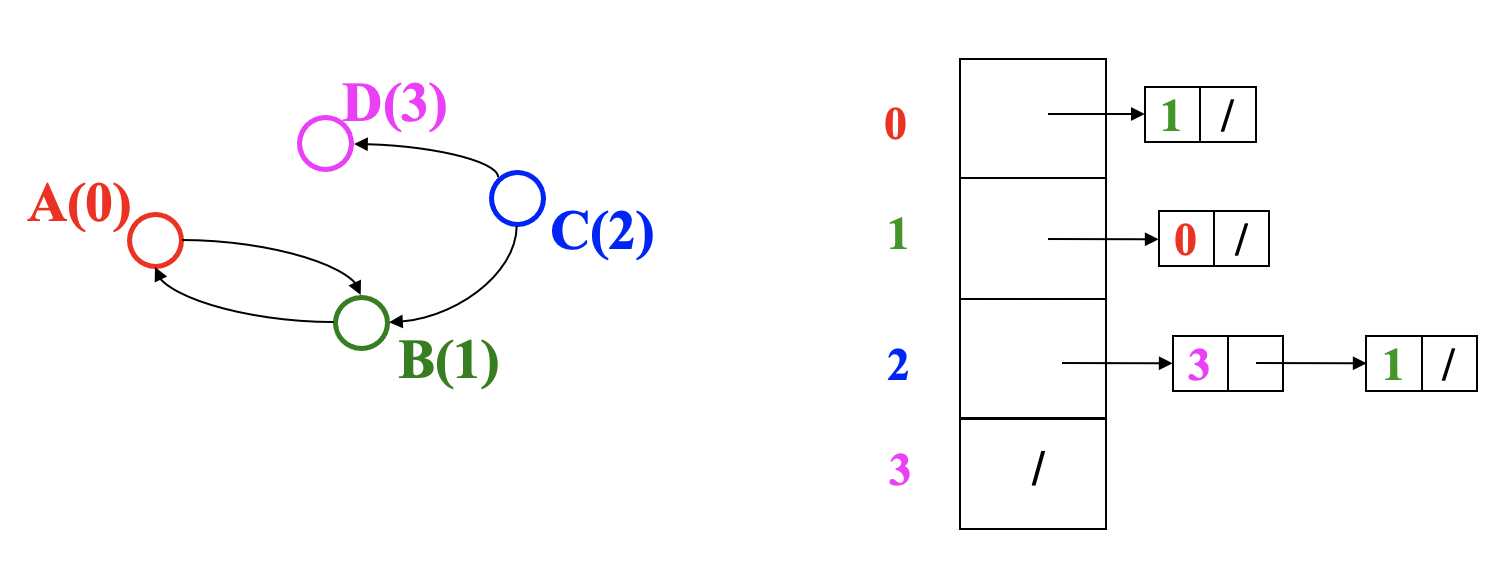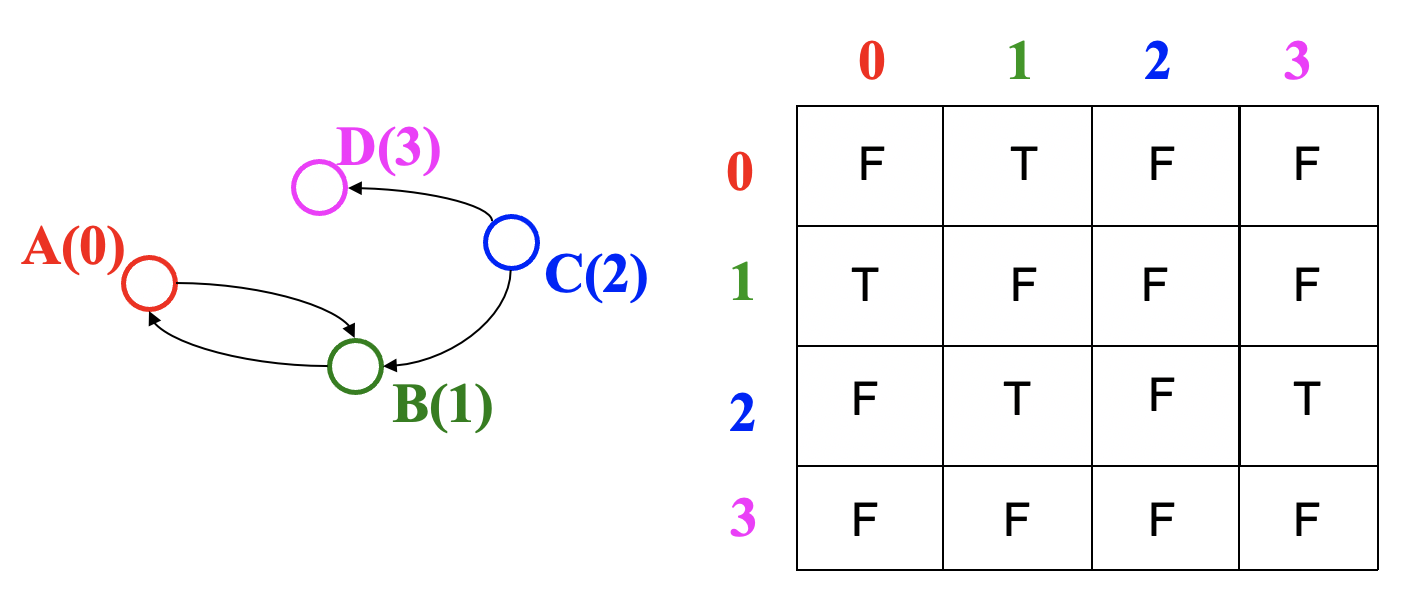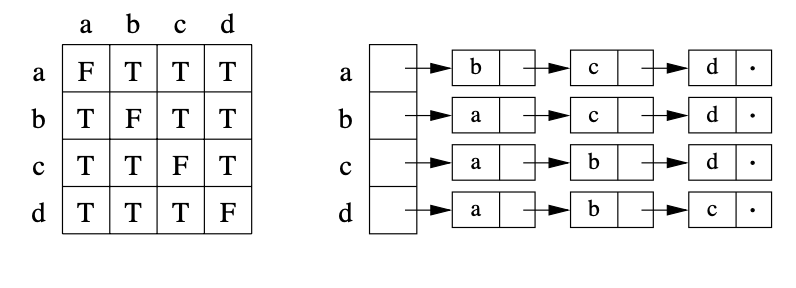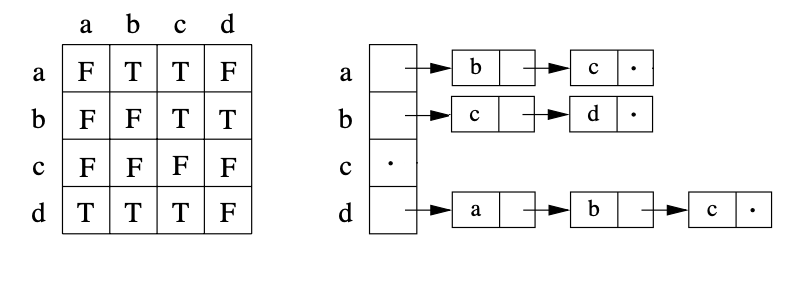Graph Data Structures
Table of Contents
1 Reading
Read Algorithms 4.1 and Algorithms 4.2
2 Learning Goals
After this lesson you will be able to
- Describe two data structures for representing graphs: the adjacency list and the adjacency matrix
- Choose the appropriate data structure based on graph properties and desired operations
- Implement an adjacency list in Java
3 Adjacency List
- Assign each node a number from 0 to \(|V|-1\)
- Represent graph as an array of length \(|V|\) in which each entry stores a list of all adjacent vertices (e.g., linked list)

- Running time to:
- Get all of a vertex's out-edges: \(O(d)\) where \(d\) is out-degree of vertex
- Get all of a vertex's in-edges: \(O(|E|)\) (but could keep a second adjacency list for this!)
- Decide if some edge exists: \(O(d)\) where \(d\) is out-degree of source
- Insert an edge: \(O(1)\) (unless you need to check if it's there)
- Delete an edge: \(O(d)\) where \(d\) is out-degree of source
- Space requirements: \(O(|V|+|E|)\)
- Best for dense or sparse graphs?
- Best for sparse graphs (so lists of neighbors are short)
4 Adjacency Matrix
- Assign each node a number from 0 to \(|V|-1\)
- Represent the graph as a \(|V| \times |V|\) matrix (i.e., 2-D array) of Booleans (or 1 vs. 0)
- If
Mis the matrix, thenM[u][v]beingtruemeans there is an edge fromutov

- Running time to:
- Get a vertex's out-edges: \(O(|V|)\)
- Get a vertex's in-edges: \(O(|V|)\)
- Decide if some edge exists: \(O(1)\)
- Insert an edge: \(O(1)\)
- Delete an edge: \(O(1)\)
- Space requirements: \(|V|^2\) matrix entries
- Best for sparse or dense graphs?
- Best for dense graphs (the matrix can handle large numbers of edges more efficiently than the adjacency list)
5 Visualizations
6 Implementing a Graph class
For this implementation of an adjacency list, I use hash tables (HashMap and HashSet) instead of an array of linked lists to make the coding easier.
This is a tradeoff of space (a HashSet may have unused spots in its internal array whereas a LinkedList would not) for time (checking whether an edge exists becomes \(O(1)\) instead of \(O(d)\)).
The logic of the data structure remains the same.
/** * An implementation of an undirected graph using an adjacency list * Vertex labels are strings * (c) 2021 Aaron Bauer */ import java.util.HashMap; import java.util.HashSet; import java.util.Map; import java.util.Set; public class Graph { Map<String, Set<String>> adjList; // maps vertices to a set of their neighbors public Graph() { adjList = new HashMap<>(); } public void addVertex(String v) { if (!adjList.containsKey(v)) { adjList.put(v, new HashSet<String>()); } } public void addEdge(String u, String v) { // adding an edge will also add the vertices to the graph if needed addVertex(u); addVertex(v); adjList.get(u).add(v); adjList.get(v).add(u); } // return a set of the vertices in the graph public Set<String> V() { // construct a new HashSet that's a copy of the key set for adjList // so that changes to the returned set don't affect the graph return new HashSet<>(adjList.keySet()); } public Iterable<String> neighbors(String v) { // construct a new HashSet that's a copy of the set of neighbors // so that changes to the returned set don't affect the graph return new HashSet<>(adjList.get(v)); } public void removeVertex(String v) { for (String u : neighbors(v)) { adjList.get(u).remove(v); } adjList.remove(v); } public void removeEdge(String u, String v) { adjList.get(u).remove(v); adjList.get(v).remove(u); } public boolean containsVertex(String v) { return adjList.containsKey(v); } public boolean containsEdge(String u, String v) { return containsVertex(u) && containsVertex(v) && adjList.get(u).contains(v); } }
7 Practice Problems1
Draw the adjacency matrix and list representations of the following (undirected and complete) graph:

Draw the adjacency matrix and list representations of the following (directed) graph:

- Draw the adjacency matrix and list representations of a full binary tree with seven nodes and undirected edges.
- Compare and contrast the performance of the adjacency list and adjacency matrix implementations of graphs.
8 Exercise
- Using the adjacency list implementation above as a starting point, implement a
Graphclass that uses an adjacency matrix - The type for a 2D array in Java is
TYPE[][], such asboolean[][] matrix - Really just an array of arrays (not a matrix in the mathematical sense)
matrix = new boolean[10][10];would create a 10-by-10 2D array of booleans- You access element in row
iand columnjlikematrix[i][j] - Your constructor can take in the number of vertices (e.g., you don't need to support adding or removing vertices, just edges)
import java.util.ArrayList; import java.util.HashMap; import java.util.Map; public class GraphMatrix { private Map<String, Integer> indexLookup; private Map<Integer, String> reverseLookup; private int nextIndex; private boolean[][] adjMatrix; public GraphMatrix(int V) { adjMatrix = new boolean[V][V]; indexLookup = new HashMap<>(); reverseLookup = new HashMap<>(); nextIndex = 0; } private int validateVertex(String v) { if (nextIndex == adjMatrix.length) { throw new IndexOutOfBoundsException("More than " + adjMatrix.length + " vertices have been added to the graph"); } if (!indexLookup.containsKey(v)) { indexLookup.put(v, nextIndex++); reverseLookup.put(indexLookup.get(v), v); } return indexLookup.get(v); } public void addEdge(String u, String v) { int i = validateVertex(u); int j = validateVertex(v); adjMatrix[i][j] = true; } public void removeEdge(String u, String v) { int i = validateVertex(u); int j = validateVertex(v); adjMatrix[i][j] = false; } // return an iterable of the vertices neighboring v public Iterable<String> neighbors(String v) { int i = validateVertex(v); ArrayList<String> result = new ArrayList<>(); for (int j = 0; j < adjMatrix.length; j++) { if (adjMatrix[i][j]) result.add(reverseLookup.get(j)); } return result; } // return the degree of vertex v public int degree(String v) { int i = validateVertex(v); int result = 0; for (int j = 0; j < adjMatrix.length; j++) { if (adjMatrix[i][j]) result++; } return result; } }
Footnotes:
1
Solutions:



- The adjacency list is generally used when the graph is relatively sparse, and is likely to use less space than the adjacency matrix implementation. The adjacency matrix is used when graphs with more than \(O(n)\) edges connect \(n\) nodes. It allows for fast access to specific edges—all in constant time, but at the cost of \(O(n^2)\) space.